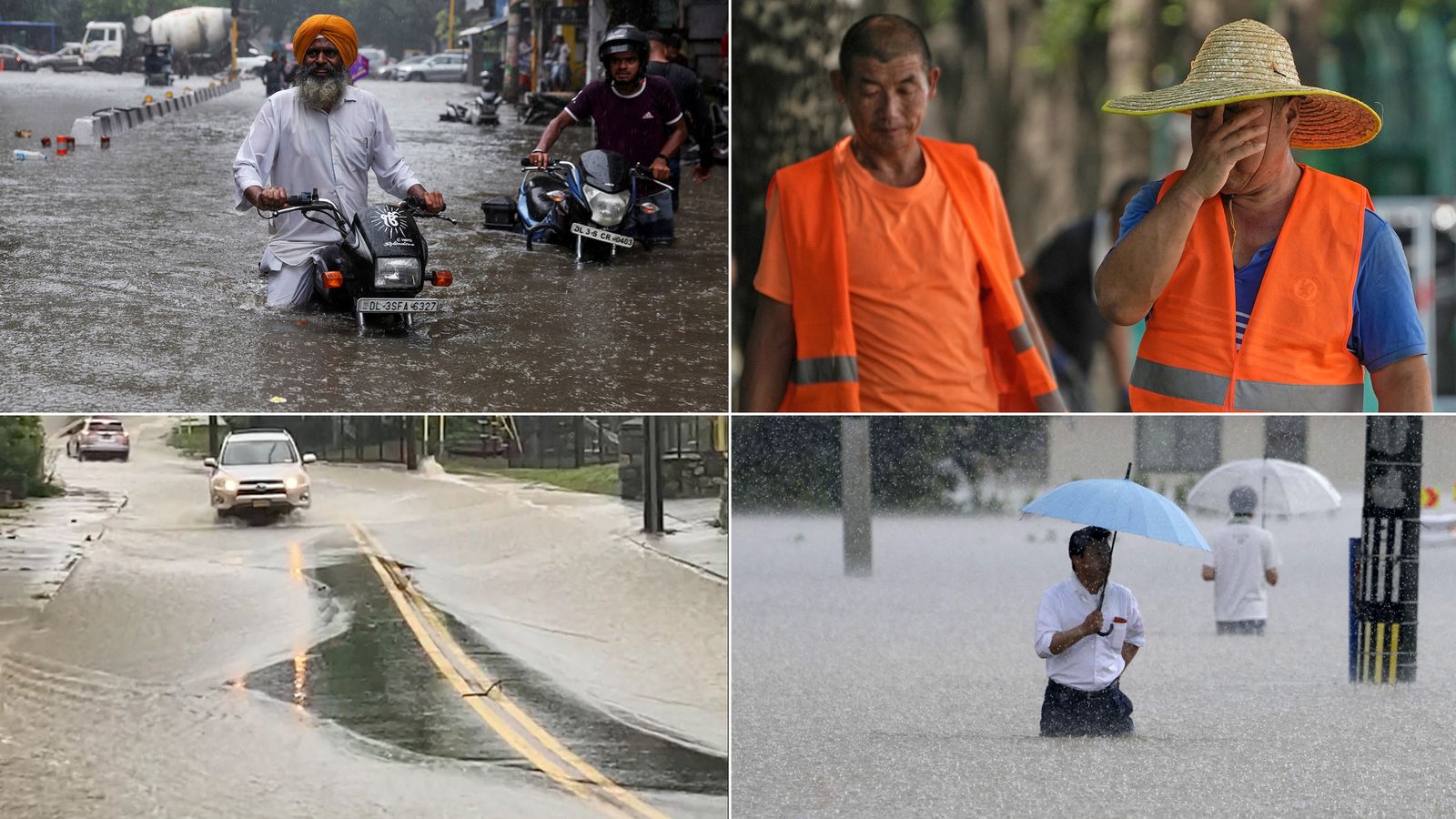Countries around the world are experiencing extreme weather from landslides and flash flooding to scorching temperatures.
In some areas, its caused casualties, triggered evacuations and further weather warnings. Here, we take a look at some of the most recent events and why they may be happening.
In Japan, the highest-level heavy rain warning was issued in parts of the Fukuoka and Oita prefectures in Kyushu – the country’s third-largest island.
Two people have died and six others were missing according to officials, as authorities urged tens of thousands of residents to move out of areas in danger of more landslides and flooding.
Some parts of Fukuoka have been hit with more than 600mm of rain since Friday, more than usually falls in the whole of July, media reported.
Be the first to get Breaking News
Install the Sky News app for free
Director of forecast division at Japan’s Meteorological Agency, Satoshi Sugimoto, said another 100mm of rain is expected up to early on Tuesday.
“The land ministry said eight rivers had burst their banks from continuous rain since late last month turned into mudslides.
Mr Sugimoto said: “The rain is becoming so heavy unlike anything seen before.”
As of Monday 1,820 households were without power while 60 homes had no water, a government spokesperson said.
The weather bureau said there was a 90% chance that the El Nino phenomenon, a warming of ocean surface temperatures in the eastern and central Pacific, would continue into the autumn.
India
Meanwhile in northern India, torrential rain has caused landslides and flash flooding as schools in New Delhi were closed after heavy rains lashed the national capital over the weekend.
Authorities and local media said on Monday that at least 22 people have died.
Many districts in the northern state of Himachal Pradesh received a month’s rainfall in a day at the weekend, a senior weather department official said.
Please use Chrome browser for a more accessible video player
Delhi, Punjab, and Himachal Pradesh have received 112%, 100% and 70% more rainfall than average so far in the current monsoon season that started on 1 June, the department added. Authorities used helicopters to rescue people stranded on roads and bridges because of the rain.
Himachal Pradesh’s Chief Minister Sukhvinder Singh Sukhu urged people to “stay inside” their homes as more heavy rain was expected.
Record set for world’s hottest day
The extreme weather comes as the world recorded its hottest day on record last Thursday, breaking previous highs set on Monday and Tuesday as global average temperatures continue to climb.
Experts have blamed a combination of climate change and an emerging El Nino weather pattern.
The global average temperature hit 17.23C on Thursday, according to data from the US National Centers on Environmental Prediction.
China
In China, torrid heat has gripped the country for several weeks, pushing local governments to ask residents and businesses to curb the usage of electricity.
Weather forecasters issued a string of heat advisories across northern parts of the country last Thursday, as temperatures were expected to breach 40C in some areas, stressing taxed power grids.
Beijing issued a red warning, the highest in a three-tier alert system, as other alerts were also issued in the northern Hebei province, Shaanxi, Henan and Shandong provinces.
Weather experts have predicted the extreme temperatures could eclipse last year’s scorching spell, which lasted for more than two months.
United States
Heavy rainstorms also poured over parts of New York and Pennsylvania on Sunday, as emergency services rescued people stuck in vehicles along flooded roadways.
Rescue teams in Hudson Valley found the body of a woman in her 30s. She is reported to have drowned after being swept away while trying to evacuate her home, Orange County Executive Steven Neuhaus told WABC-TV
Online footage showed rushing flood waters in Stony Point, a small town on the Hudson River about 40 miles north of Manhattan.
Read more:
Tornado strikes in Indiana sending debris flying
Greta Thunberg charged with disobeying police order at protest
Bryan Jackson, a meteorologist with the National Weather Service’s Weather Prediction Centre, said a weather pattern more typical of cooler months had built over the Canadian province of Ontario and was interacting with the regular summer moisture.
The centre issued its first-ever high-risk warning, the highest level on a four-step scale, for the area surrounding Burlington, Vermont, on Monday.
“We expect considerable to locally catastrophic impacts,” Mr Jackson said.











